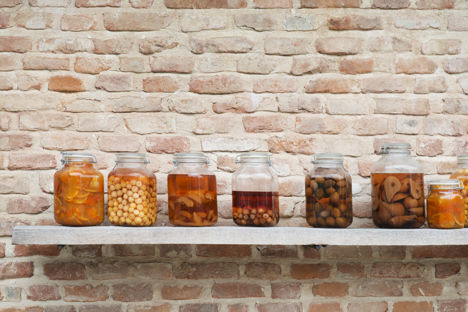
The art and science of pickling
Chloë King takes a look at Britain’s rich history of pickling before shedding light on the entire process from start to finish.
In the beginning
We have been preserving things in vinegar for literally thousands of years, meaning this method of food preservation is unarguably one of our most favoured and effective. At times of scarcity, along comes the humble pickle to relieve us of boredom or, more impressively, vitamin deficiencies. At times of feast, what better way to perk up a Boxing Day banquet than with a large dollop of piccalilli and a pickled onion?
‘When dishes survive there is good reason,’ writes Diana Henry in her excellent book Salt Sugar Smoke. ‘They are lodged in a country’s culture; they’re not faddy.’ So it is with pickles, which, on reading up, you will find have not changed significantly since the beginning.
In her eponymous Book of Household Management, Mrs Beeton writes endearingly of Greek and Roman pickles that ‘consisted of flowers, herbs, roots and vegetables preserved in vinegar’. Their various ingredients, macerated in oil, brine and vinegar, ‘often impregnated drop by drop’.
Of course, we have plenty of variations, from quick pickles to not-in-the-least-quick pickles, water pickles to oil pickles, refrigerator pickles to fermented pickles. But no matter where you go in the world, the one golden rule of pickling has remained since antiquity; to preserve all you can of the best quality you can find while it is available.
The essential components
Unlike some other dishes in the original Mrs Beeton, the spectrum of pickling recipes it contains would not feel out of place in a twenty-first century cookbook. Fancy a pickled nasturtium bud on your chia seed and sprouted mung bean salad? I do.
It’s unsurprising really. Today, top chefs like René Redzepi are celebrated for using often overlooked seasonal ingredients at their point of prime and preparing them in ways that are executed with precision. As if to prove that all good things come back around, Beeton recommended that we gather fruits intended for preservation ‘in the morning, in dry weather, with the morning sun upon them’. This harvest will have the ‘fullest flavour’, and keep well for longest, she said. The biggest mistake that novices make when making preserves of any kind, is using fruit and vegetables that are either over- or under-ripe.
Aside from an enviable batch of fresh produce, the essential element in pickle is of course vinegar, for its antimicrobial acetic acid. The word vinegar comes from the French vin aigre, which translates as sour wine. This is important to note, because not all vinegar is born equal, and more worrisomely, not all ‘vinegar’ is vinegar, as you will find if you read the side of the ‘non-brewed condiment’ commonly found at the chippy.
Good pickling vinegar should be a minimum of five percent acidity, and of a reliable quality. Unless you’re an expert, this is not one to make at home. The acetic acid plays a crucial role in warding off the growth of harmful bacteria that flourish in neutral or alkaline conditions and the balance of this is crucial to making a successful pickle.
In Britain, our favourite pickles are strongly influenced by Indian achars, and the most used pickling vinegar for the last century has been full-flavoured dark malt vinegar, which holds up well to the addition of spices (although you might equally go for a good quality cider vinegar). For a more authentic Nordic pickle, white wine or white vinegar does well, while Asian pickles are often made with rice vinegar.
The third thing to remember, in the same vein, is that the salt you use must be pure rock or sea salt. Conventional table salts contain additives that may make your sparklingly clear pickling liquor look like river water.
The process
Before modern farming methods made it possible to obtain vegetables out of season, it was common to keep adding ingredients to pickles as and when they were ready to harvest. In today’s germ-phobic era, the idea of opening and closing the pickle jar in such a manner is the stuff of nightmares.
In her book An Invitation to Indian Cooking, Madhur Jaffrey explains with relish how her grandmother insisted her celebrated lime pickles should only be stirred with the bare hand of a servant named Ishri, else they would spoil. As if to prove her right, Jaffrey reports that no other cook in the neighbourhood was able to make lime pickle to the same recipe.
Indeed, second to choosing the best ingredients for your pickle is your choice of how to make it. This is where things become a little reliant on your own willingness to experiment, as there are many slight variations on the basic method of brining raw vegetables, followed by bottling them in seasoned vinegar.
The humble pickled onion, for instance, can be subject to numerous treatments to varying ends. One Mrs Beeton method recommends brining the onions for three days; cooking them in hot, not boiling, milk and water solution, leaving them overnight then covering in just-boiled seasoned vinegar before bottling and leaving for four to six weeks. Another of her pickled onion recipes recommends simply covering raw peeled onions and whole spices in cold vinegar and letting them stand for a fortnight.
On the whole, twenty-four-hour brining or dry salting is necessary for pickles you intend to keep for any length of time. This stage draws out moisture from the vegetables, prohibiting it from leeching out, colouring the vinegar and diluting its acidity. Leiths suggests a ratio of 225g salt to 2.8 litres of water as an adequate brine.
Next, the vinegar is heated with whole spices that infuse flavour well and do not cloud the liquid. Juniper, allspice berries, cloves, dried chilli, bay, fennel, peppercorns and mace are common, as is the use of fresh dill. Scandinavian pickles tend to be sweeter and more dilute, with vinegar mixed 1:1 or 3:2 with water and sugar added. A stainless steel pan is necessary here, as copper, iron and brass pans can spoil in high-acidity.
Once cool, the vinegar is poured over the rinsed, prepared veg in clean jars. Rubber-sealed Kilner or parfait jars are best for pickling as they are sturdy and easily cleaned. To sterilise, rinse well in hot soapy water and heat through in a low oven for fifteen minutes. Be sure to replace the rubber seals with new after each bottling: a good fit is not guaranteed twice, and the material can deteriorate.
The twist
Pickling is as much about observation as it is invention. All cookery is about transformation, and when this process takes place over long periods of time, as it does with a pickle, it can be difficult to be precise without a good deal of experimentation and openness to chance.
The conditions your pickles are stored in, whether cool or cold, and the length of time they are kept before eating will all have an impact on the end product. A just-made pickle is typically sharper tasting, but crunchier than one that has been left to mature.
Look to individual recipes from reliable sources for tips about how best to pickle different types of vegetable according to their individual qualities. Explore international variations. Follow recipes closely when it comes to their salt, sugar and vinegar content, as this magical trio will ward off mould. You are then free to play in terms of the aromats you choose, at what point in their development you serve them and what with.
In the words of Diana Henry, ‘innovation and adventure are perfectly possible with pickles and chutneys. You don’t have to worry too much about science’.


